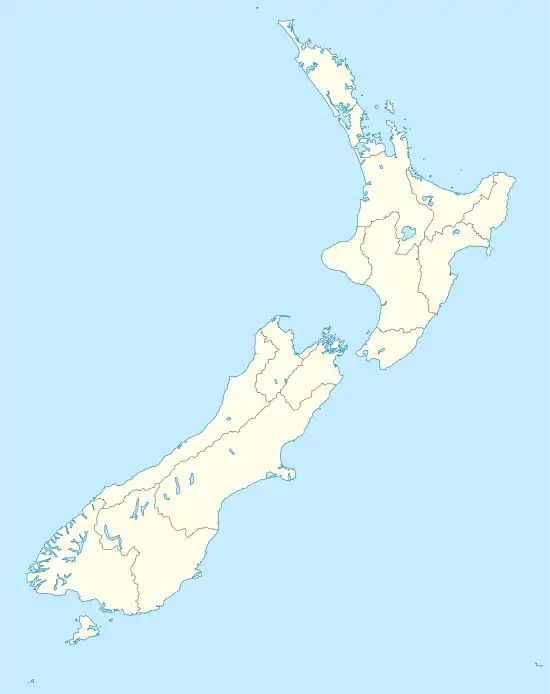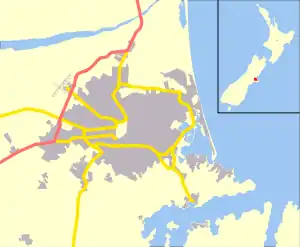Hillmorton, New Zealand
Hillmorton is a suburb of south-western Christchurch, New Zealand. The suburb is centred around the intersection of Lincoln Road and Hoon hay Road, two arterial routes which form part of State Highway 75 and feed into the Christchurch Southern Motorway which runs to the north of the suburb. Ōpāwaho / Heathcote River flows through the suburb, acting as a boundary for Hillmorton's residential development on one side and the Canterbury Agricultural Park, a purpose-built complex designed to host the annual Canterbury A&P Show, on the other. It is the location of a number of schools, including Hillmorton High School, Rowley Avenue School and Spreydon School.[3]
Hillmorton | |
|---|---|
Suburb | |
 Hillmorton  Hillmorton | |
| Coordinates: 43.555231°S 172.591994°E | |
| Country | New Zealand |
| Local authority | Christchurch |
| Electoral ward | Spreydon[1] |
| Area | |
| • Land | 2,920 ha (7,220 acres) |
| Population (2018)[2] | |
| • Total | 2,838 |
| Hospitals(s) | Hillmorton Hospital |
| Middleton | Addington | |
| Wigram |
|
Spreydon |
| Aidanfield | Hoon Hay |
History
Hillmorton takes its name from Hill Morton Farm, the property of John Twigger, who settled in the area in 1863.[4] Land from the subdivision of this farm was advertised for sale in a local newspaper in 1879 as being "part of Twigger's property known as Hillmorton".[5] At the same time as Twigger settled the area, 1863 also saw the opening of the Sunnyside Hospital, Christchurch's first mental asylum. The buildings were constructed in a gothic style by architect John Campbell, and represented a shift in the approach to mental illness in the region. Where previously those with mental illnesses were held at Lyttelton Gaol,[6] the hospital was founded on the principles of moral management, providing a more supportive environment for patients.[7] Commitment to this approach varied throughout the hospital's existence, until it was closed in 1999 due to replacement by the neighbouring Hillmorton Hospital. The final buildings of the former Sunnyside Hospital were demolished in April 2007 to make way for additional housing, a move which was met with protest due to the architectural and cultural significance of the structures.[8] Hillmorton Hospital continues to act as a dedicated mental health facility for the city from nearby to the original Sunnyside location.[9]
In 1933, Hillmorton was also chosen as the site for a Carmelite monastery to be established as the order's first New Zealand presence. The monastery was originally founded in a pre-existing homestead in June 1933, with the first wing not being completed until four years later. This was followed by the addition of a subsequent wing in 1950, since which point the monastery has maintained their presence in the heart of Hillmorton.[10]
References
- "Wards, Councillors and Community Boards map". ccc.govt.nz. Christchurch City Council. Retrieved 14 August 2020.
- "2018 Census place summaries: Hillmorton". www.stats.govt.nz. Statistics New Zealand. Retrieved 24 August 2020.
- "Hillmorton High School". School website. Retrieved 30 May 2020.
- Harper, Margaret. "Christchurch Street Names: H" (PDF). Christchurch City Libraries. p. 95. Retrieved 31 May 2020.
- "Christchurch Place Names: A – M" (PDF). christchurchcitylibraries.com. Christchurch City Libraries. Retrieved 23 August 2020.
- Blake-Palmer, Geoffrey. 1966. 'Hospitals, Mental', In A. H. McLintock, ed., An Encyclopaedia of New Zealand. (Accessed 19 August 2007)
- Watson, Katharine. "Inside an asylum". Christchurch Uncovered. Underground Overground Archaeology. Retrieved 23 August 2020.
- "Sunnyside Hospital". my.christchurchcitylibraries.com. Christchurch City Libraries. Retrieved 23 August 2020.
- "Hillmorton Hospital". Hospital website. Retrieved 30 May 2020.
- "History". Carmelite Monastery of Christ the King Christchurch, New Zealand. Carmelite Monastery, Christchurch. Retrieved 23 August 2020.